
The Beretta 92 is a series of semi-automatic pistols designed and manufactured by Beretta of Italy. The Beretta 92 was designed in 1975, and production began in 1976. Many variants in several calibers continue to be used to the present.
The Beretta 92G-SD and 96G-SD Special Duty handguns are semi-automatic, locked-breech delayed recoil-operated, double/single-action pistols, fitted with the heavy, wide Brigadier slide, chambered for the 9×19mm Parabellum cartridge (92G-SD) and the .40 S&W cartridge (96G-SD), framed with the addition of the tactical equipment rail, designed and manufactured by Beretta.

The Walther P99 is a semi-automatic pistol developed by the German company Carl Walther GmbH Sportwaffen of Ulm for law enforcement, security forces and the civilian shooting market as a replacement for the Walther P5 and the P88. The P99 and its variants are also made under licence by Fabryka Broni Radom.

The SIG Sauer P220 is a semi-automatic pistol designed in 1975 by the SIG Arms AG division of Schweizerische Industrie Gesellschaft, and produced by J. P. Sauer & Sohn, in Eckernförde. It is currently manufactured by both SIG Sauer companies: SIG Sauer GMBH, of Eckernförde, Germany; and SIG Sauer, Inc., of New Hampshire, United States.

The Beretta M1951 is a 9×19mm semi-automatic pistol developed during the late 1940s and early 1950s by Pietro Beretta S.p.A. of Italy. The pistol was produced strictly for military use and was introduced into service with the Italian Armed Forces and other Italian security forces as the Modello 1951 (M1951), replacing the Modello 1934 pistol chambered for the 9×17mm Short cartridge.

The Walther P38 is a 9 mm semi-automatic pistol that was developed by Carl Walther GmbH as the service pistol of the Wehrmacht at the beginning of World War II. It was intended to replace the comparatively complex and expensive to produce Luger P08. Moving the production lines to the more easily mass producible P38 once World War II started took longer than expected, leading to the P08 remaining in production until September 1942 and copies remained in service until the end of the war.

The Vz. 50 is a Czechoslovakian made double-action, semi-automatic pistol. Vz is an abbreviation of the Czech term "vzor" meaning model.
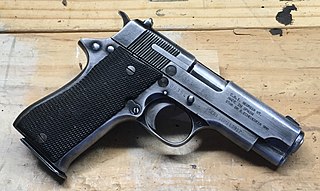
The Star Model BM is a single-action semi-automatic pistol that fires the 9 mm Parabellum pistol cartridge. It was produced by Star Bonifacio Echeverria, S.A. in Spain and is a compact version of the full size Star Model B. Although its external appearance resembles the classic M1911, its design is different in several respects. For example, the Star does not have the 1911's grip safety. In addition, the thumb safety on the Star BM blocks the hammer, whereas it blocks the motion of the sear on a 1911 and the Star's trigger pivots on a roll pin rather than moving straight back like a 1911A1's trigger to trip the sear. The pistol is fed by an 8-round detachable box magazine.
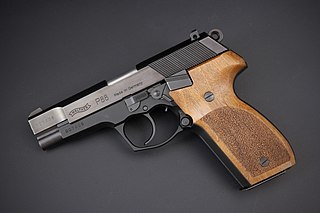
The Walther P88 is a semiautomatic pistol developed by German company Walther. Its main feature is a double-stacked magazine designed for military and law enforcement use. The P88 was succeeded by the Walther P99 in 1997.

The Colt Model 1900 is a short-recoil operated "self-loading", or semi-automatic .38 caliber handgun introduced by Colt's Manufacturing Company at the turn of the 20th century. The M1900 was the first firearm to be chambered in .38 ACP and was the first handgun to utilize short-recoil operation.
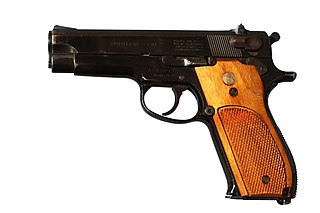
The Smith & Wesson Model 39 is a semiautomatic pistol developed for the United States Army service pistol trials of 1954. After the Army abandoned its search for a new pistol, the Model 39 went on the civilian market in 1955 and was the first of Smith & Wesson's first generation semi-automatic pistols.
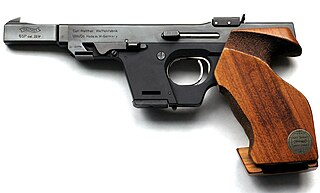
The Walther GSP, Gebrauchs Sportpistole, is a semi automatic, precision targetshooting pistol with an unlocked breech action made in Germany by Walther Sportwaffen. It has the same technical base as the Walther OSP and thus is almost identical in outward appearance, albeit slightly longer and heavier than the OSP.

A handgun is a firearm designed to be usable with only one hand. It is distinguished from a long barreled gun which typically is intended to be held by both hands and braced against the shoulder. Handguns have shorter effective ranges compared to long guns, and are much harder to shoot accurately. While most early handguns are single-shot pistols, the two most common types of handguns used in modern times are revolvers and semi-automatic pistols.

The Walther PPS is a semi-automatic pistol developed by the German company Carl Walther GmbH Sportwaffen of Ulm for concealed carry for civilians and plainclothes law enforcement personnel. It is available in either 9×19mm Parabellum or .40 S&W chamberings. It was first shown in 2007 at the IWA & OutdoorClassics and is a slim polymer framed weapon of similar size to the Walther PPK pistol. The PPS is however technically much more based on the Walther P99 pistol.
The Walther Model 1936 Olympia II is a single action semi-automatic handgun manufactured by Walther. The first version was the M1925, formally known as the Automatic Walther Sport Pistol cal. 22 LR, and was introduced in 1925. It was followed by the M1932, the Olympia Pistole I, and used to good effect in the 1932 Olympic Games. The final development Walther made was the M1936 Olympia II that won five gold medals at the 1936 Berlin Olympics and effectively ended the Olympic reign of the Colt Woodsman Target model. The pistol continued to be manufactured up until 1944, but no major changes were made during the war. In 1952 the pistol was reintroduced under license by Hämmerli-Walther. In 1957 Smith & Wesson introduced the Model 41, based on the Olympia-Pistole. The Norinco TT Olympia is a Chinese copy of the Walther M1936 Hunter made sometime after 1980. Most variants were chambered for the .22 Long Rifle but the Schnellfeuer version used the .22 short, produced to equip the German team for the Berlin Olympic Games of 1936 for the rapid fire events. The Olympia pistol is a fixed barrel, internal hammer, open-topped slide design and had a large contoured wooden grip which extended well below the bottom of the butt frame causing the necessity of the magazine bottom plate to be fitted with a wooden block extension. Once World War II started, the need for weapons quickly shifted from competition and sport to the military, thus Olympia production slowed.
The Fabarm FP6 is a pump-action combat shotgun that was manufactured by the Italian firearms company Fabbrica Bresciana Armi S.p.A. (FABARM) and sold by Heckler & Koch. It was intended for civilian and law enforcement use.
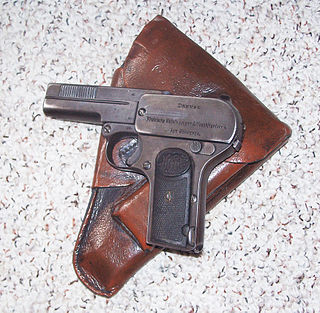
The Dreyse Model 1907 is a semi-automatic pistol designed by Louis Schmeisser. The gun was named after Nikolaus von Dreyse, the designer and inventor of the Dreyse Needle Gun. The Waffenfabrik von Dreyse company was acquired by Rheinische Metallwaren & Maschinenfabrik Sömmerda in 1901, although the Dreyse Model pistols were marketed under the Dreyse name.

In firearms, a safety or safety catch is a mechanism used to help prevent the accidental discharge of a firearm, helping to ensure safer handling.

The Walther PPQ is a semi-automatic pistol developed by the German company Carl Walther GmbH Sportwaffen of Ulm for law enforcement, security forces and the civilian shooting market as a development of the Walther P99. It is available in 9×19mm Parabellum, 9×21mm, .40 S&W, and .45 ACP chamberings.

The Smith & Wesson Model 422, is a semi automatic .22 LR pistol manufactured by Smith & Wesson.

















